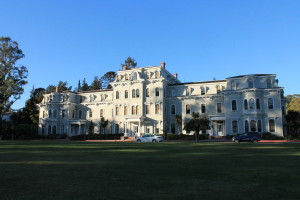
In early May, the City of Oakland, UC Berkeley and the East Bay Regional Parks Department accepted a $5.6 million grant to thin out the concentration of trees in the East Bay Hills that would reduce the fire hazard in vulnerable areas.
The grant was requested 10 years ago under the Federal Emergency Management Agency’s (FEMA) Pre Disaster Mitigation Program to fund a project that would aim to reduce wildfire hazards. The severity of California’s drought and the flammability of the oil that is present in eucalyptus trees was used as their argument for the requested funds. The plan also aims to preserve native plants over the next ten years. Some residents in these areas rejected the plan because herbicides are being applied to the remaining tree stubs to avoid regrowth.
The Hills Conservation Network is one of the many organizations fighting for conservation in the East Bay Hills, specifically the Claremont Canyon and Strawberry Canyon regions. It filed a lawsuit against FEMA in March to prevent the funding and implementation of the project.
Peter Scott, a member of the organization, believes that the removal of trees would not be the solution to prevent wildfire. They advocate for protecting the current ecosystem and preventing wildfires caused by humans.
“I’m speaking as someone who was there for the ‘70 fire and the ‘91 fire,” Scott said. “I lost my house [and I] lost family members. I don’t want to see another fire. The trees are not the problem. They did not start the ‘91 fire. It is an urban fire problem. Almost all of the fires are set by humans.”
The Hill Conservation Network also argues that FEMA’s plan is more hazardous than the current state of the hills.
“The people that are promoting this are looking for the hills to return to something 200 years ago where there were grasslands and occasional oak. That is the type of landscape that burns every year,” Scott said.
Many residents are also worried about the herbicide application to the tree stubs because of the possible health hazards they pose. In an effort to address these issues, Robert Doyle, the manager of the East Bay Regional Parks department, sent an open letter to concerned residents about how the herbicide would be managed safely.
“In some areas, trained personnel will be hand-applying very small amounts of Garlon to prevent stumps from re-growing. Garlon has been proven safe for this purpose. It will not be applied near creeks or other water sources. Less than 20 gallons will be used annually over the 800 acres of ridgeline in the East Bay Hills” Doyle said in the letter.
FEMA’s plan report claims that the potential for contaminated water sources and adverse health effects from these herbicides would be worse in the aftermath from a wildfire than from the proposed plan. Residents are still concerned about the herbicide’s agency since they come from corporate GMO companies.
Although FEMA’s plan began in August, some issues with its implementation have already come up.
On Sept. 4, another organization, Save the East Bay Hills, reported on their Facebook about an incident that came from composting some of the cut down trees from the plan. Firefighters were called to the scene in Redwood Regional Park after a resident reported that a mulch pile from a recently cut down pine tree was steaming. The steam was the result of heat from composting debris.
Many organizations are still actively protesting FEMA’s plan, but nothing has halted the implementation of it. The plan will happen over a period of 10 years and it is expected to change the landscape of the East Bay Hills as we know it today.




